2023 TOYOTA PRIUS ECO mode
[x] Cancel search: ECO modePage 579 of 770
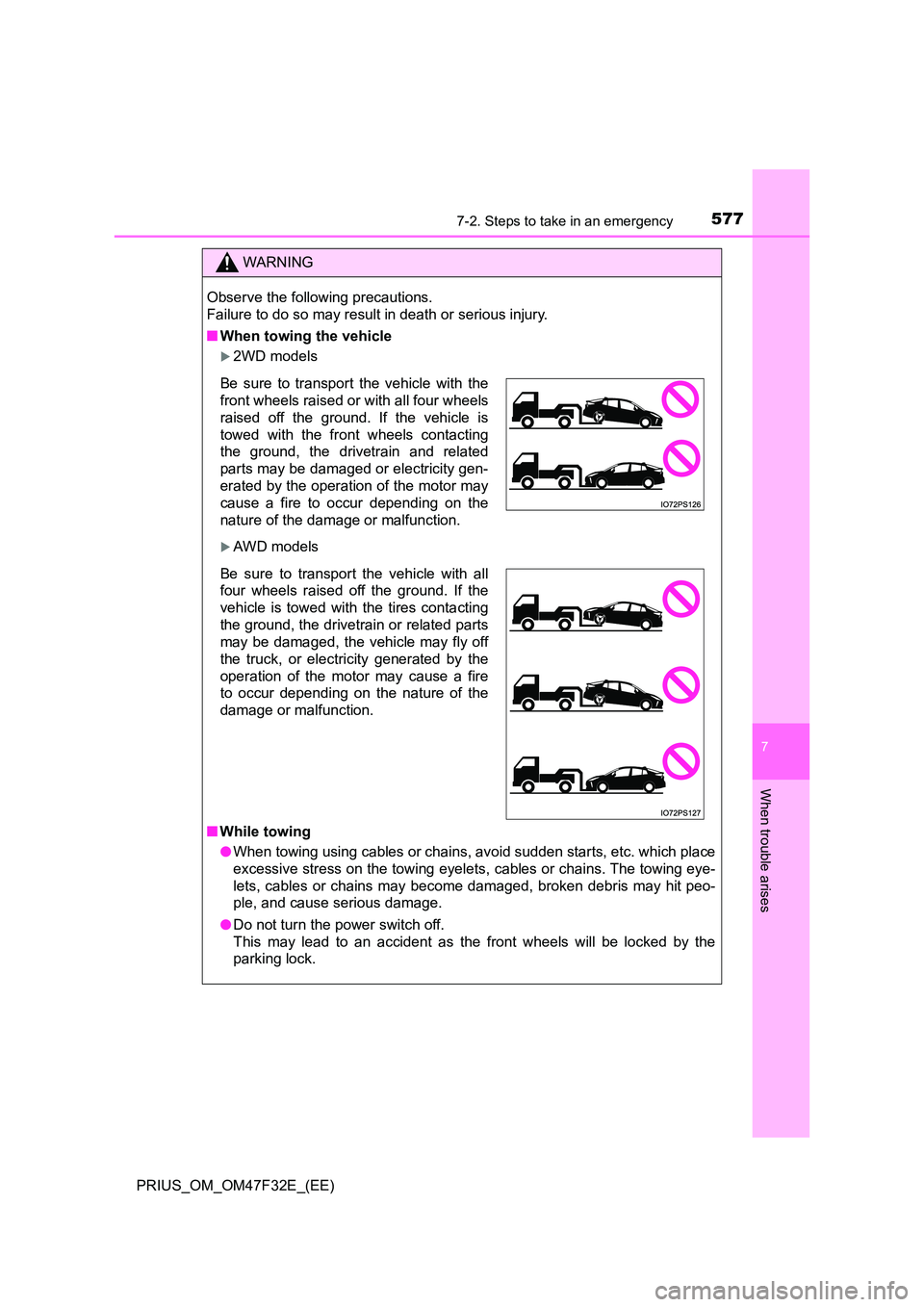
5777-2. Steps to take in an emergency
PRIUS_OM_OM47F32E_(EE)
7
When trouble arises
WARNING
Observe the following precautions.
Failure to do so may result in death or serious injury.
■ When towing the vehicle
2WD models
AWD models
■ While towing
● When towing using cables or chains, avoid sudden starts, etc. which place
excessive stress on the towing eyelets, cables or chains. The towing eye-
lets, cables or chains may become damaged, broken debris may hit peo-
ple, and cause serious damage.
● Do not turn the power switch off.
This may lead to an accident as the front wheels will be locked by the
parking lock.
Be sure to transport the vehicle with the
front wheels raised or with all four wheels
raised off the ground. If the vehicle is
towed with the front wheels contacting
the ground, the drivetrain and related
parts may be damaged or electricity gen-
erated by the operation of the motor may
cause a fire to occur depending on the
nature of the damage or malfunction.
Be sure to transport the vehicle with all
four wheels raised off the ground. If the
vehicle is towed with the tires contacting
the ground, the drivetrain or related parts
may be damaged, the vehicle may fly off
the truck, or electricity generated by the
operation of the motor may cause a fire
to occur depending on the nature of the
damage or malfunction.
Page 588 of 770

5867-2. Steps to take in an emergency
PRIUS_OM_OM47F32E_(EE)
*5: Rear passengers’ seat belt warning buzzer:
The rear passengers’ seat belt warning buzzer sounds to alert the rear
passenger that his or her seat belt is not fastened. If the seat belt is unfas-
tened, the buzzer sounds intermittently for a certain period of time, after
the seat belt is fastened and unfastened and the vehicle reaches a certain
speed.
*6: This symbol is displayed on the multi-information display.
■ Front passenger detection sensor, seat belt reminder and warning
buzzer
● If luggage is placed on the front passenger seat, the front passenger detec-
tion sensor may cause the warning light to flash and the warning buzzer to
sound even if a passenger is not sitting in the seat.
● If a cushion is placed on the seat, the sensor may not detect a passenger,
and the warning light may not operate properly.
■ Electric power steering system warning light (warning buzzer)
When the 12-volt battery charge becomes insufficient or the voltage tempo-
rarily drops, the electric power steering system warning light may come on
and the warning buzzer may sound.
■ If the malfunction indicator lamp comes on while driving
For some models, the malfunction indicator lamp will come on if the fuel tank
becomes completely empty. If the fuel tank is empty, refuel the vehicle imme-
diately. The malfunction indicator lamp will go off after several trips.
If the malfunction indicator lamp does not go off, contact any authorized
Toyota retailer or Toyota authorized repai rer, or any reliable repairer as soon
as possible.
■ When the tire pressure warning light comes on (if equipped)
Inspect the appearance of the tire to check that the tire is not punctured.
If the tire is punctured: P. 598, 618
If the tire is not punctured:
Carry out the following procedure after the tire temperature has lowered suffi-
ciently.
● Check the tire inflation pressure and adjust to the appropriate level.
● If the warning light does not go out even after several minutes, check that
the tire inflation pressure is at the specified level and carry out initialization.
( P. 531)
The warning light may come on again if the above operations are conducted
without first allowing the tire temperature to lower sufficiently.
Page 637 of 770
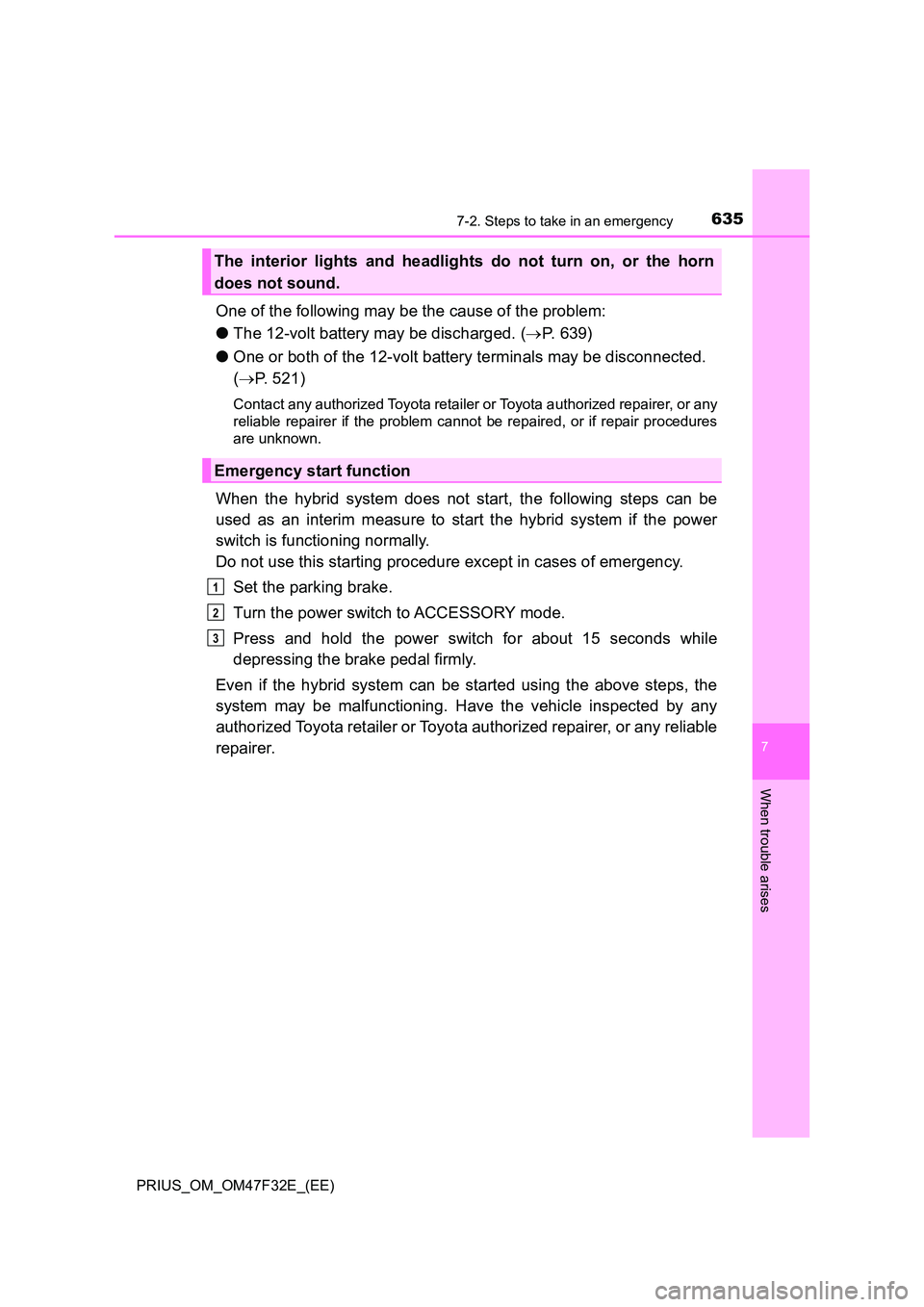
6357-2. Steps to take in an emergency
PRIUS_OM_OM47F32E_(EE)
7
When trouble arises
One of the following may be the cause of the problem:
● The 12-volt battery may be discharged. (P. 639)
● One or both of the 12-volt battery terminals may be disconnected.
( P. 521)
Contact any authorized Toyota retailer or Toyota authorized repairer, or any
reliable repairer if the problem cannot be repaired, or if repair procedures
are unknown.
When the hybrid system does not start, the following steps can be
used as an interim measure to start the hybrid system if the power
switch is functioning normally.
Do not use this starting procedure except in cases of emergency.
Set the parking brake.
Turn the power switch to ACCESSORY mode.
Press and hold the power switch for about 15 seconds while
depressing the brake pedal firmly.
Even if the hybrid system can be started using the above steps, the
system may be malfunctioning. Have the vehicle inspected by any
authorized Toyota retailer or Toyota authorized repairer, or any reliable
repairer.
The interior lights and headlights do not turn on, or the horn
does not sound.
Emergency start function
1
2
3
Page 640 of 770
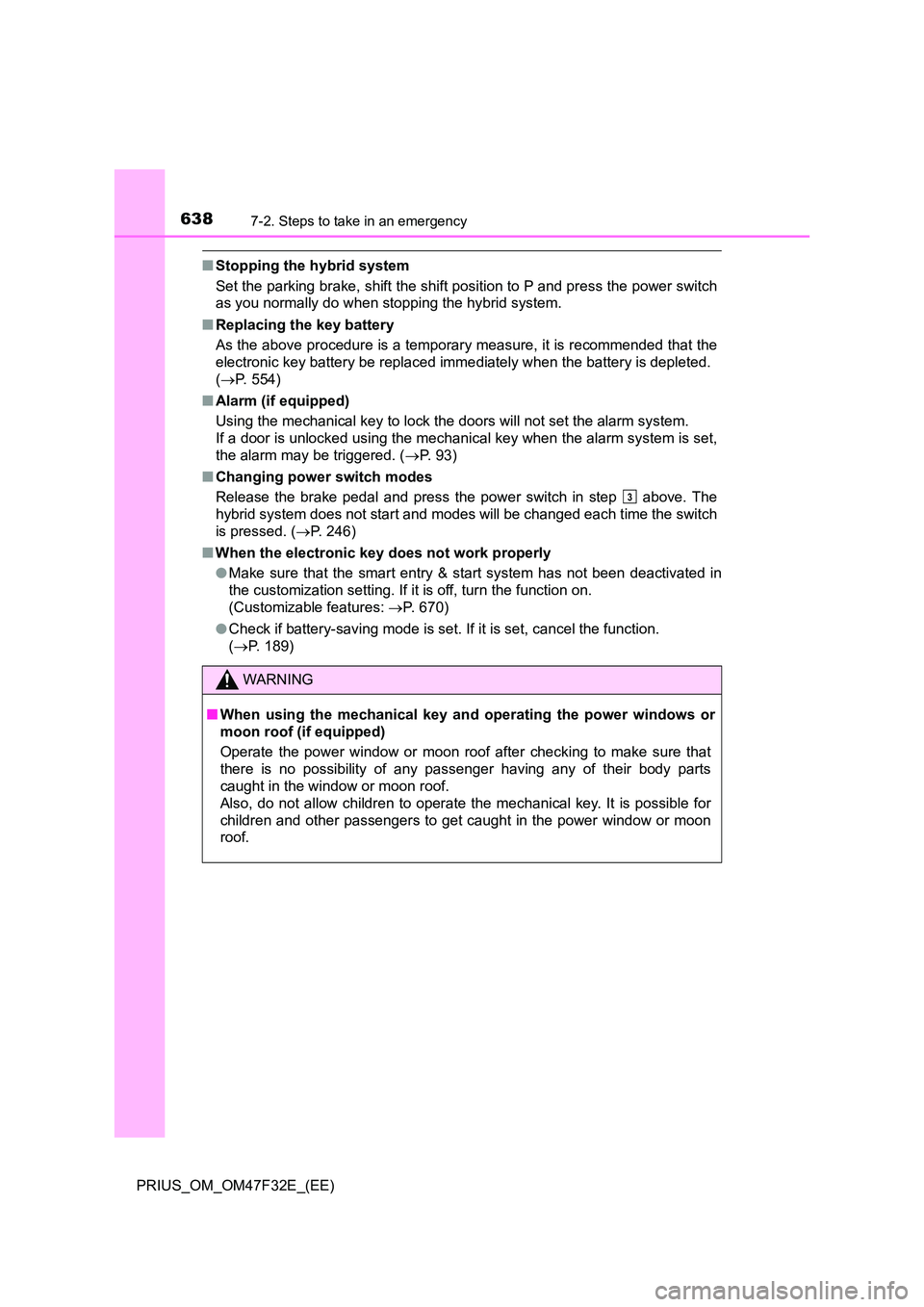
6387-2. Steps to take in an emergency
PRIUS_OM_OM47F32E_(EE)
■Stopping the hybrid system
Set the parking brake, shift the shift position to P and press the power switch
as you normally do when stopping the hybrid system.
■ Replacing the key battery
As the above procedure is a temporary measure, it is recommended that the
electronic key battery be replaced imm ediately when the battery is depleted.
( P. 554)
■ Alarm (if equipped)
Using the mechanical key to lock the doors will not set the alarm system.
If a door is unlocked using the mechanical key when the alarm system is set,
the alarm may be triggered. ( P. 9 3 )
■ Changing power switch modes
Release the brake pedal and press the power switch in step above. The
hybrid system does not start and modes will be changed each time the switch
is pressed. ( P. 246)
■ When the electronic key does not work properly
● Make sure that the smart entry & start system has not been deactivated in
the customization setting. If it is off, turn the function on.
(Customizable features: P. 670)
● Check if battery-saving mode is set. If it is set, cancel the function.
( P. 189)
WARNING
■When using the mechanical key and operating the power windows or
moon roof (if equipped)
Operate the power window or moon roof after checking to make sure that
there is no possibility of any passenger having any of their body parts
caught in the window or moon roof.
Also, do not allow children to operate the mechanical key. It is possible for
children and other passengers to get caught in the power window or moon
roof.
3
Page 642 of 770

6407-2. Steps to take in an emergency
PRIUS_OM_OM47F32E_(EE)
Connect the jumper cables according to the following procedure:
Connect a positive jumper cable clamp to the positive (+) battery
terminal on your vehicle.
Connect the clamp on the other end of the positive cable to the
positive (+) battery terminal on the second vehicle.
Connect a negative cable clamp to the negative (-) battery termi-
nal on the second vehicle.
Connect the clamp at the other end of the negative cable to a
solid, stationary, unpainted metallic point away from the 12-volt
battery and any moving parts, as shown in the illustration.
Start the engine of the second vehicle. Increase the engine speed
slightly and maintain at that level for approximately 5 minutes to
recharge the 12-volt battery of your vehicle.
Maintain the engine speed of the second vehicle and start the
hybrid system of your vehicle by turning the power switch to ON
mode.
Make sure the “READY” indicator comes on. If the indicator light
does not come on, contact any authorized Toyota retailer or Toyota
authorized repairer, or any reliable repairer.
4
1
2
3
4
32
4
1
5
6
7
Page 644 of 770
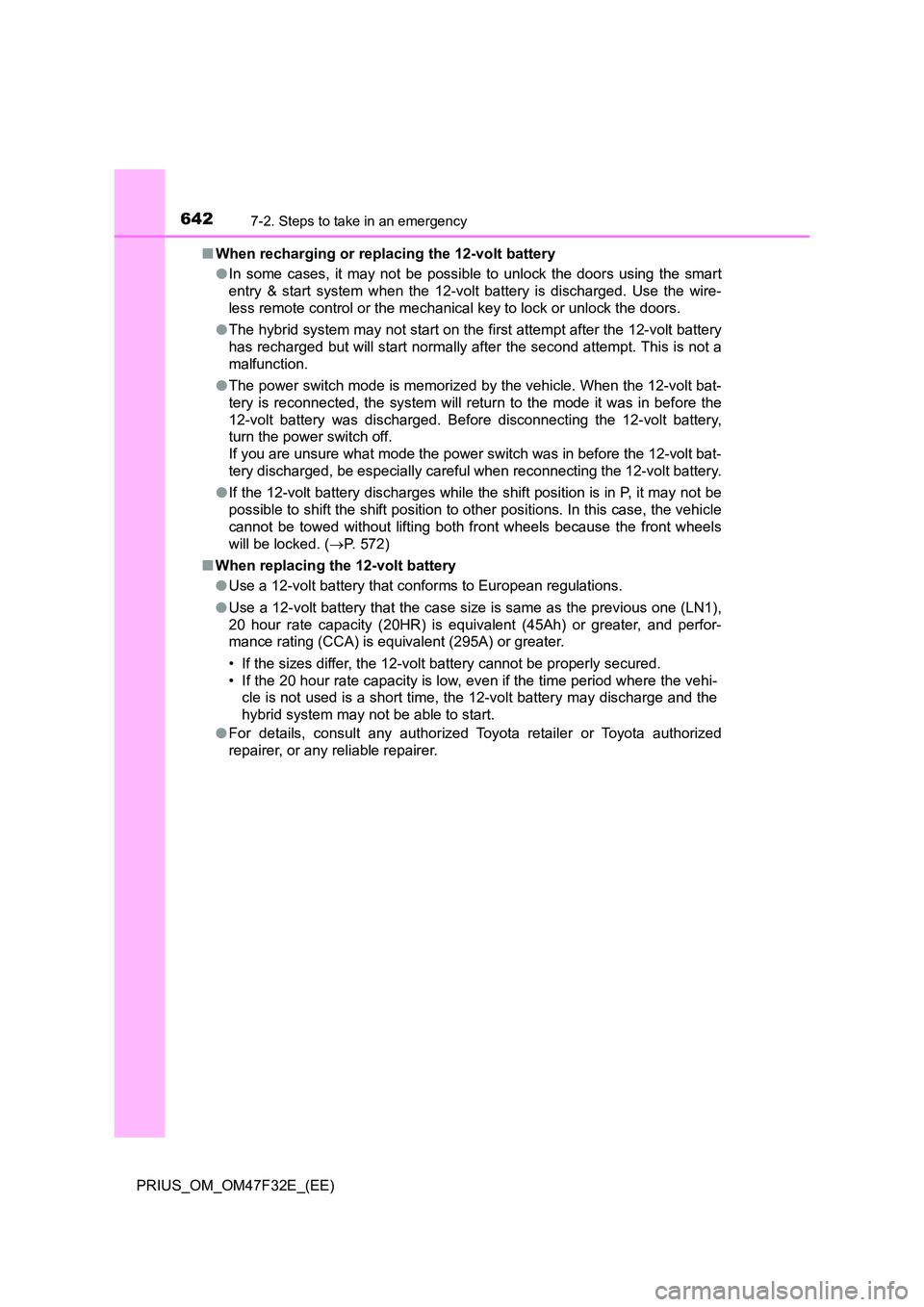
6427-2. Steps to take in an emergency
PRIUS_OM_OM47F32E_(EE)
■ When recharging or replacing the 12-volt battery
● In some cases, it may not be possible to unlock the doors using the smart
entry & start system when the 12-volt battery is discharged. Use the wire-
less remote control or the mechanical key to lock or unlock the doors.
● The hybrid system may not start on the first attempt after the 12-volt battery
has recharged but will start normally after the second attempt. This is not a
malfunction.
● The power switch mode is memorized by the vehicle. When the 12-volt bat-
tery is reconnected, the system will return to the mode it was in before the
12-volt battery was discharged. Before disconnecting the 12-volt battery,
turn the power switch off.
If you are unsure what mode the power switch was in before the 12-volt bat-
tery discharged, be especially careful when reconnecting the 12-volt battery.
● If the 12-volt battery discharges while the shift position is in P, it may not be
possible to shift the shift position to other positions. In this case, the vehicle
cannot be towed without lifting both front wheels because the front wheels
will be locked. ( P. 572)
■ When replacing the 12-volt battery
● Use a 12-volt battery that conforms to European regulations.
● Use a 12-volt battery that the case size is same as the previous one (LN1),
20 hour rate capacity (20HR) is equi valent (45Ah) or greater, and perfor-
mance rating (CCA) is equivalent (295A) or greater.
• If the sizes differ, the 12-volt battery cannot be properly secured.
• If the 20 hour rate capacity is low, even if the time period where the vehi-
cle is not used is a short time, the 12-volt battery may discharge and the
hybrid system may not be able to start.
● For details, consult any authorized Toyota retailer or Toyota authorized
repairer, or any reliable repairer.
Page 677 of 770
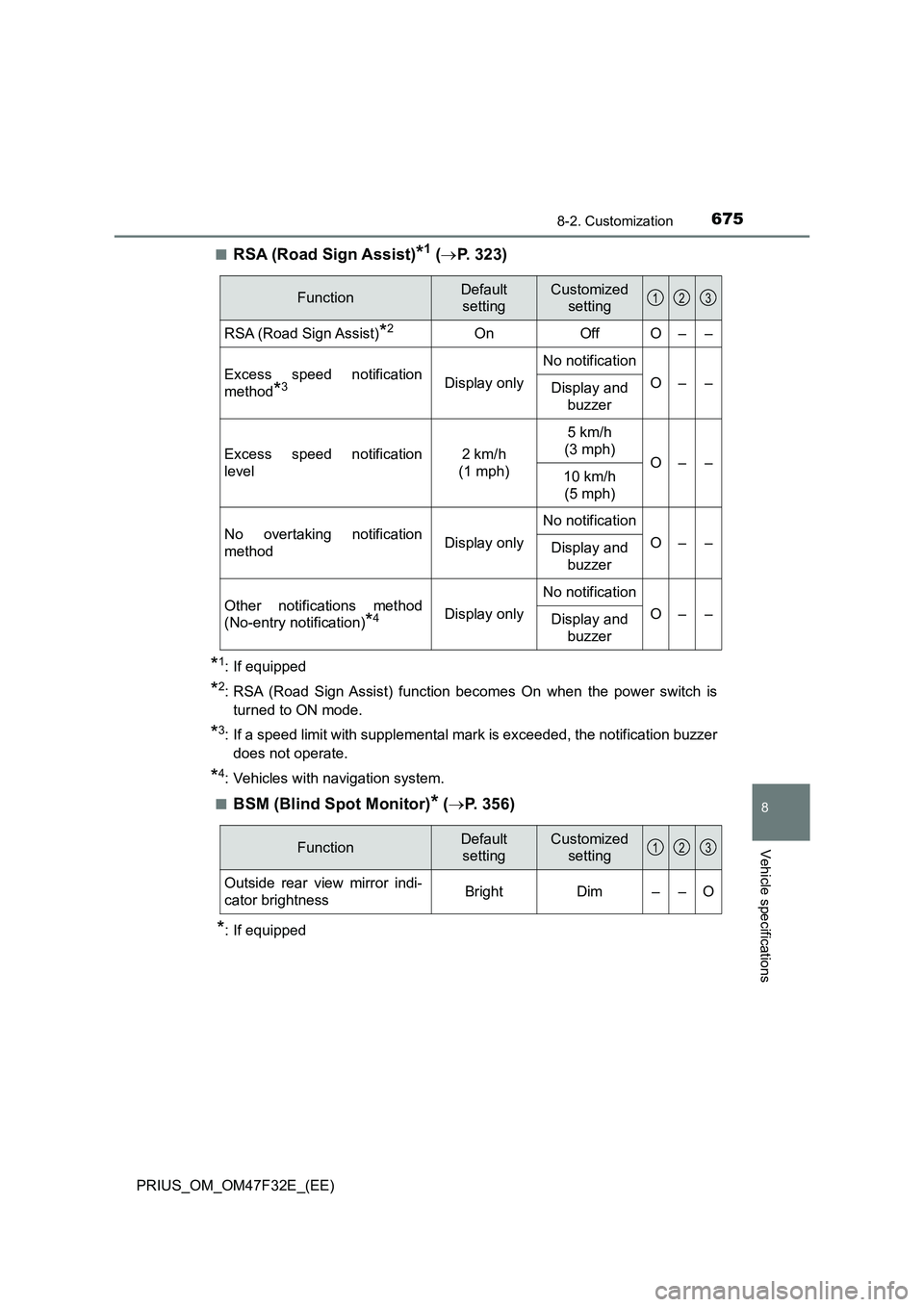
6758-2. Customization
PRIUS_OM_OM47F32E_(EE)
8
Vehicle specifications
■RSA (Road Sign Assist)*1 (P. 323)
*1: If equipped
*2: RSA (Road Sign Assist) function becomes On when the power switch is
turned to ON mode.
*3: If a speed limit with supplemental mark is exceeded, the notification buzzer
does not operate.
*4: Vehicles with navigation system.
■
BSM (Blind Spot Monitor)* (P. 356)
*: If equipped
FunctionDefault
settingCustomized
setting
RSA (Road Sign Assist)*2OnOffO––
Excess speed notification
method
*3Display only
No notification
O––Display and
buzzer
Excess speed notification
level2 km/h
(1 mph)
5 km/h
(3 mph)
O––10 km/h
(5 mph)
No overtaking notification
methodDisplay only
No notification
O––Display and
buzzer
Other notifications method
(No-entry notification)
*4Display only
No notification
O––Display and
buzzer
123
FunctionDefault
settingCustomized
setting
Outside rear view mirror indi-
cator brightnessBrightDim––O
123
Page 688 of 770

686Alphabetical index
PRIUS_OM_OM47F32E_(EE)
Alphabetical index
A/C............................................. 458
Air conditioning filter.............. 542
Automatic air conditioning
system ................................ 458
Blower customization ............ 462
Eco score (A/C score) ........... 150
Front seat concentrated
airflow mode (S-FLOW)...... 461
ABS (Anti-lock Brake
System) .................................. 441
Function ................................ 441
Warning light ......................... 581
ACA (Active Cornering
Assist) .................................... 441
Active Cornering Assist
(ACA) ...................................... 441
AHB (Automatic High
Beam) ..................................... 266
Air conditioning filter .............. 542
Air conditioning system .......... 458
Air conditioning filter.............. 542
Automatic air conditioning
system ................................ 458
Blower customization ............ 462
Eco score (A/C score) ........... 150
Front seat concentrated
airflow mode (S-FLOW)...... 461
Air intake vent ............................ 85
Cleaning ................................ 545
Airbag manual on-off
system ...................................... 51Airbags ....................................... 39
Airbag manual on-off
system .................................. 51
Airbag operating conditions .... 45
Airbag precautions for your
child ...................................... 41
Airbag warning light .............. 581
Correct driving posture ........... 32
Curtain shield airbag
operating conditions ............. 46
Curtain shield airbag
precautions........................... 43
General airbag precautions .... 41
Locations of airbags................ 39
Modification and disposal of
airbags.................................. 44
Side airbag operating
conditions ............................. 46
Side airbag precautions .......... 42
Side and curtain shield
airbags operating
conditions ............................. 46
Side and curtain shield
airbags precautions .............. 43
SRS airbags............................ 39
Alarm .......................................... 93
Alarm ...................................... 93
Intrusion sensor ...................... 96
A